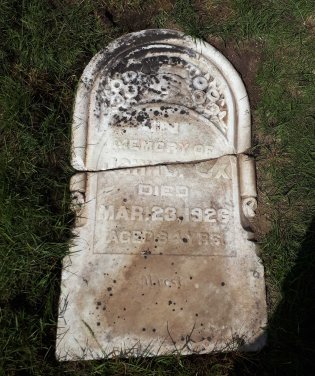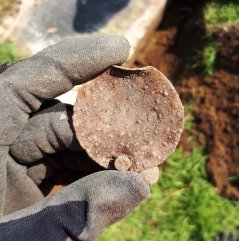Goodness it’s been a busy week, and I’ve learned so much! We took on some cool repairs, cleaned some neat stones, and answered some questions from the public along the way too! It was a pretty good time overall, and I can’t believe we are nearly halfway through the program (thank you to Canada Summer Jobs program to opening your funding up to young people who aren’t going back to school this fall, me and everyone else really appreciate it!!).
There are a few new posts from the last week over at the Woodland Cemetery history blog, about children’s gravestones and our first ‘solo expedition‘ setting a broken gravestone! But it’s time for a review of the entire week, lets get into it!

The first big accomplishment of the week was out first complicated reset. This gravestone was broken into three pieces, and partially underground (you can tell which parts were buried for ages because they are the cleanest! Lichen didn’t have a chance to grow), and needed to be dug out, moved, and reset. I talked about the first stages of this project in my post last week (HERE), and this is the end result! We decided to use wood dowels so that if the repair fails in the future, the dowels will break with the stone, rather than causing further damage by attempting to hold the stone up. This could cause additional pieces to snap off with the pressure. The stone feels a little wobbly if you touch the top, but we believe this has something to do with how huge it is! (and you can tell the base isn’t moving at all).




I was beyond excited to see this gravestone go up, as our first solo repair. I have worked with historic burial grounds in some capacity on and off since 2011, when I attended my first ever field school with the Centre for Manx Studies and studied burial grounds in Ireland and the Isle of Man (and excavated at Ballanorris. Can you spot me in this documentary?). I’ve known about conservation technique for gravestones and burial ground for years, but other than some preventative conservation, this job is my first opportunity to learn all the physical repairs! I love it, and I’ve been loving learning it all so far!
The same day that we finished setting Helen’s stone, we also recovered and reset the gravestone of Eliza Wright, who died in 1854. This was an exciting recovery because her stone was moved from St. Paul’s churchyard after Woodland opened in 1879, and her family has continued to use the plot where her gravestone is to this day. Her stone was almost completely underground as well, but in one piece, so all we had to do was clean it with water and D2, and pack a hole with limestone screening to prevent quick sinking. Then we set the stone in the hole while ensuring that the poem on the base of the stone was legible, packed it 90% full with limestone screening, and covered the remaining with soil and sod. Tada!




Now, what is interesting about these two gravestones is that neither of them have a key, or large cement or stone base. Keys were popular later in the 1800s and onwards, and did not require as much excavation to erect the gravestone as the key sits on the surface or on a buried cement foundation rather than requiring a deep hole to be dug. Based on the length of the gravestones, their 1850s dates (note: dates of gravestones are often off by a year or two due to the time it sometimes takes to bury the individual or have the stone carved), and noting where the text on the stone stopped. If these gravestones had keys, they would have a notch at the base that had been set into the key, and the text would have taken up more of the face of the stone. This wasn’t the case for either, so we knew we could reset them directly into the ground. Isn’t that cool?

Gravestone of John C. Cox
The best conservation for gravestones is the method that prevents further damage to the stone without inflicting addition damage, and keeps the stone’s inscription from being exposed to additional weathering. As much as it isn’t great because we can’t see them, the safest place for fallen gravestones is actually underground! Some stones will probably remain underground too (unfortunately we can’t recover them all), but when we do bring one to the surface, the goal is to have it standing again as soon as possible. This way, the face of the gravestone isn’t subjected to lawnmowers, feet (human and deer), and the impact of falling rain. If we can get them upright again, the impact of direct physical weathering will be much less, and preserve the inscription a little longer!
Unfortunately this isn’t always possible, for a number of reasons. With the example above, we decided not to repair and reset the gravestone because of the size and the state of the stone itself. You can’t see it in that photo, but that gravestone is over 5 cm thick, made of solid marble. Around the edges and the break in the middle, the stone has gotten very soft and crumbles just from touching it. If we were to drill into this stone for pins, there is a high chance it could crumble away from us, causing addition damage. We didn’t want that, so instead we removed the stone from where it fell for cleaning, and created a new bed of limestone screening to support the weight of the stone while allowing drainage, and raising the stone back to ground level. The stone has been recorded for the cemetery’s records, but we will not be resetting it upright. Sometimes, documentation and treatments like this are the best option.
Finally this week, we completed our first complex repair that used both pinning and a latex sealant between sections of the monument! This was exciting because we hadn’t used the latex yet but it is what is used to attach contemporary monuments together, so we had better know how to use it! I believe it lasts for a decade or so before it starts to fail, which is only a real issue on tall, leaning monuments because gravity will pull those down at some point…but if the monument is level, gravity tends to hold it together pretty well, sealant or not!




When we found the stone, it appeared that the top section had been knocked off or fallen off. We set to work chipping the old sealant off the bottom, leveling the base with limestone screening, and cleaning the stone. I rolled out the latex putty sealant and placed a dime in each corner. This is to ensure the stone sits at the same level on each side! Getting the middle section back onto the base was the easy part, and even measuring and drilling the dowel holes was pretty easy…but getting them lined up wasn’t! As you can tell, the gravestone is extremely thick, and required 2 people to lift it repeatedly and hold it suspended to see if the pin holes lined up. When they didn’t, it went down again and we got back to measuring and drilling. This process took about an hour, and eventually we had it all figured out, and set the stone!

Crematory Tag #199
As you can see in the photos, we also braced the stone to keep it from falling over the weekend, and also used a few small pieces of dowel under the edges of the base (turned out the back of the stone had broken, leaving it on an angle) to keep the stone level. We will seal those supports inside with lime mortar on Monday (my favourite part!)
It was definitely a busy week, and we even managed to write those 2 blog posts for the cemetery in the midst of it all as well! I’m looking forward to seeing what projects we get to next week…including returning to the Chinese immigrant section to see if there are any more stones we can recover to help fill in the story of that portion of the cemetery. I will leave you this week with the old crematory tag that Brienna dug up! Canada’s first crematory opened in 1901 (Mount Royal Cemetery, Montreal), and London’s first crematory was constructed at Woodland Cemetery (I will find out the year). If this is one of our cremation tags, reading #199, then we have far surpassed it today, with over 27,000 cremations having taken place at Woodland.
I should probably get back to working on my papers now! In case you hadn’t already heard via twitter, I will be submitting 2 abstracts to the SHA 2020 conference in Boston, MA. One for a paper about protective symbols in mortuary contexts, and one for a poster with my friend Sarah, discussing the challenges of gravestone conservation with organizations and volunteer groups. I can’t wait!
As always, thanks for reading!

June 9, 2019 at 10:53 pm
Thank you for writing! Enjoyed reading about the processes.
LikeLiked by 1 person
June 9, 2019 at 10:56 pm
Thank you Marion! We have 5 more weeks ahead, there will be lots to come 😀
LikeLike
June 9, 2019 at 11:35 pm
Most fascinating work, Robyn; you and Brienna are saints for doing this. It makes me want to go to my maternal relative’s cemetery (Botany, just east of Chatham) and do some straightening up! Although I know that a distant relative maintains the grounds quite well. There are, though, some broken/leaning/fallen stones; the cemetery is 150+ years old. Lots of history to be read!
Thanks again. I will be following your work with interest!
LikeLiked by 1 person
June 9, 2019 at 11:48 pm
Thanks for your support, I appreciate it!! I bet your family would love to see those stones recovered (make sure to check with whatever authority is needed before doing any ground disturbance in a cemetery. If it is a historic site you may need an archaeologist!) 🙂
LikeLike
June 10, 2019 at 6:50 am
I believe my 3rd great grandfather is buried there. We can’t seem to find out for sure. They believe he came from St Paul’s. William Henry Hargreaves. I am hoping some day to get there and explore myself.
Love the article on this and what you are doing. So amazing.
LikeLiked by 1 person
June 10, 2019 at 12:53 pm
Thank you so much! That’s amazing! We will take a look for his stone and can send you photos if you like? Would you be able to send me your email address?
LikeLike